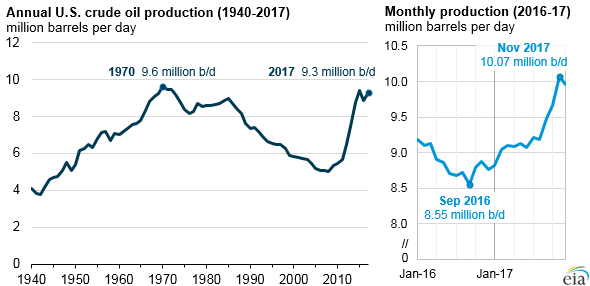U.S. About to Shatter Oil Production Records
Remember the idea of “Peak Oil,” the theory that the United States (and the rest of the world) was seemingly about to run out of oil?
In 2006, then-President George W. Bush declared the United States was “addicted to oil,” and the impending shortfall in oil supplies meant the U.S. must take action to “break this addiction.”
Fast-forward 12 years and American oil producers are about to hit a very different kind of peak oil: they are about to produce more oil than they ever have before. And despite not having any oil deposits of its own, Minnesota helped play a role in this energy transformation.

According to the Energy Information Administration:
In November 2017, monthly U.S. crude oil production reached 10.07 million b/d, the highest monthly level of crude oil production in U.S. history [emphasis added]. U.S. crude oil production has increased significantly over the past 10 years, driven mainly by production from tight rock formations using horizontal drilling and hydraulic fracturing. EIA projects that U.S. crude oil production will continue to grow in 2018 and 2019, averaging 10.7 million b/d and 11.3 million b/d, respectively.
The dramatic increase in oil production since 2005 has been led by states like Texas, North Dakota, and New Mexico, which have dramatically increased their oil production thanks to hydraulic fracturing (see below):

Minnesota’s role stems from providing oil and natural gas producers with the sand used in the hydraulic fracturing process. I’ve written about the sand, commonly referred to as “frac sand,” here, but it bears repeating because Minnesota could produce more of this sand if not for the unscientific policy decisions enacted to restrict sand mining in the southeastern part of the state.
These restrictions not only affect local landowners, they impact on the entire country.
Thankfully, American oil producers have found other sources of frac sand, and that is the reason Minnesotans have enjoyed the benefits of booming oil production in the form of lower prices at the pump.